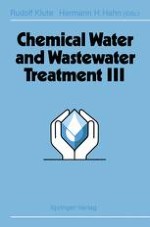1994 | OriginalPaper | Chapter
Coagulant Dosing Control Using a Model for Wastewater Coagulation
Authors : Harsha Ratnaweera, Hans Blom, Gunnar Aasgaard
Published in: Chemical Water and Wastewater Treatment III
Publisher: Springer Berlin Heidelberg
Included in: Professional Book Archive
Activate our intelligent search to find suitable subject content or patents.
Select sections of text to find matching patents with Artificial Intelligence. powered by
Select sections of text to find additional relevant content using AI-assisted search. powered by
A concept for optimum coagulant dosage control based on flexible empirical models is proposed. A method for mathematical description of wastewater coagulation using multivariate calibration methods is described. The comprehensives in describing the influent quality with several parameters, rather than with one parameter, are identified to result in the high efficiency of the models. Correlation coefficients for models with good influent descriptions were over 0.90, while models like Dosage = f (flow, effluent turbidity) resulted in a correlation coefficient of 0.58. The latter is one of the most commonly used dosing strategies today. Calibration and cross validation coefficients for models with various structures are tabulated based on laboratory-, pilot- and full scale observations. A strategy for coagulant dosing control based on these models and instrumental error identification systems with troubleshooting functions are discussed. The high flexibility of the system to handle the changes in plant configurations, coagulant types, treatment requirements, changes in the number of real-time monitoring parameters, etc. are identified as advantages.
